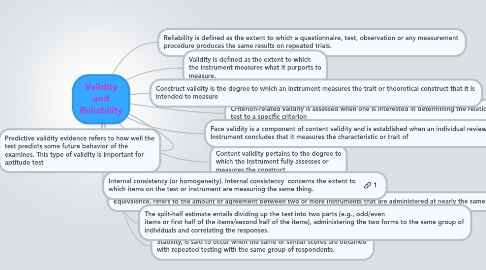Validity and Reliability
作者:Jennifer Williams

1. Predictive validity evidence refers to how well the test predicts some future behavior of the examines. This type of validity is important for aptitude test
2. Content validity pertains to the degree to which the instrument fully assesses or measures the construct
3. Stability, is said to occur when the same or similar scores are obtained with repeated testing with the same group of respondents.
4. Equivalence, refers to the amount of agreement between two or more instruments that are administered at nearly the same point in time.
5. Reliability is defined as the extent to which a questionnaire, test, observation or any measurement procedure produces the same results on repeated trials.
6. Internal consistency (or homogeneity). Internal consistency concerns the extent to which items on the test or instrument are measuring the same thing.
7. The split-half estimate entails dividing up the test into two parts (e.g., odd/even items or first half of the items/second half of the items), administering the two forms to the same group of individuals and correlating the responses.
8. Validity is defined as the extent to which the instrument measures what it purports to measure.
9. Criterion-related validity is assessed when one is interested in determining the relationship of scores on a test to a specific criterion
10. Construct validity is the degree to which an instrument measures the trait or theoretical construct that it is intended to measure
11. Face validity is a component of content validity and is established when an individual reviewing the Instrument concludes that it measures the characteristic or trait of


